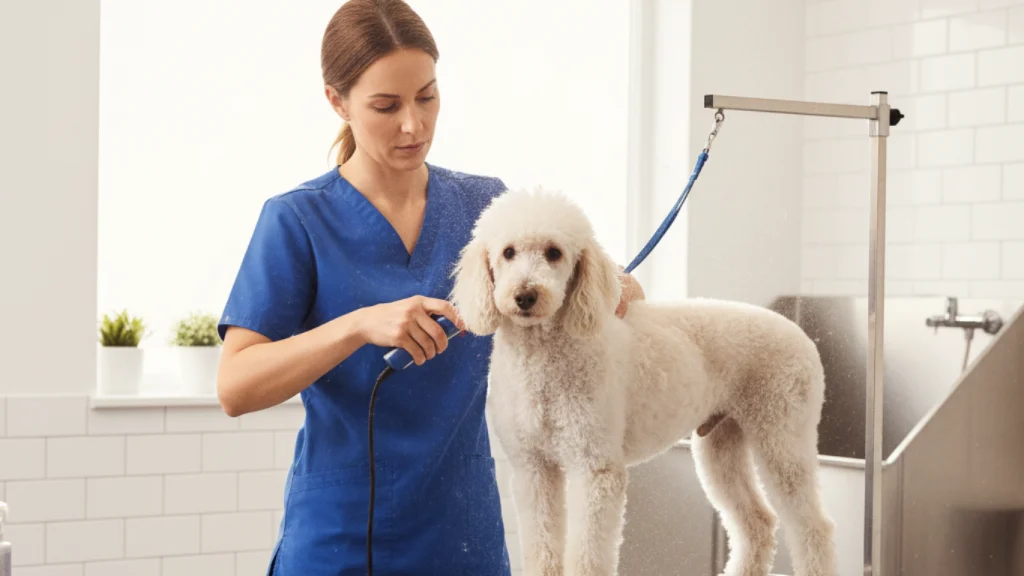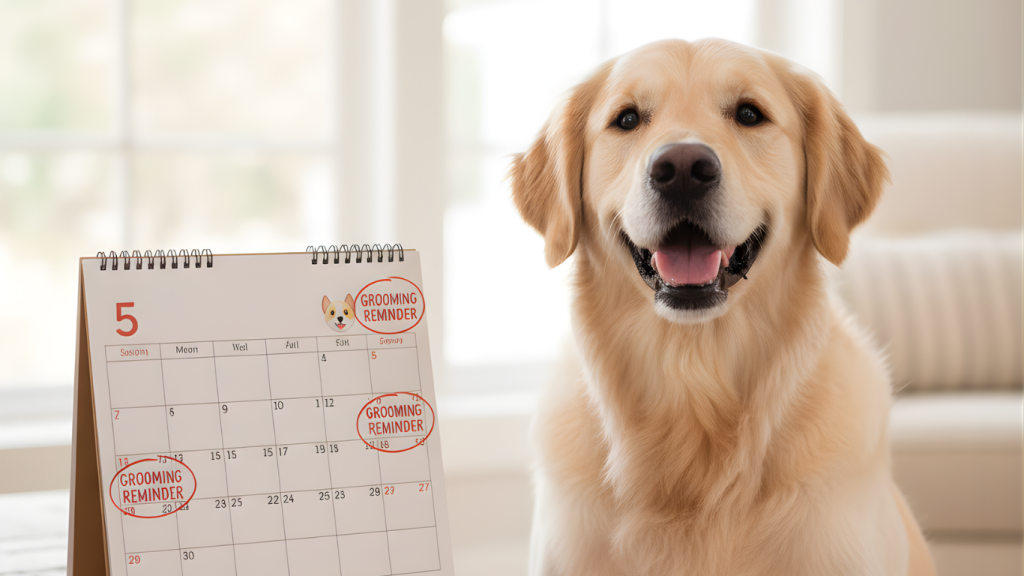As a dog owner, one of the most essential parts of caring for your dog is grooming. A good haircut not only helps your dog look their best but also contributes to their overall health and comfort. Whether you’re dealing with a dog with a thick, long coat or one with a short, low-maintenance coat, knowing how to properly groom and trim your dog’s fur can make a significant difference.
In this detailed guide, I’ll walk you through everything you need to know about dog haircuts, from understanding why they are important to the best haircut styles for different breeds and how to trim your dog’s fur at home. You’ll also get tips on choosing whether to go to a professional groomer or do it yourself, as well as how often to get your dog’s hair cut.

What You’ll Learn in This Guide:
- Why a dog haircut is essential
- How to choose the right dog haircut for your pet’s breed and coat
- How to determine whether to DIY or visit a groomer
- The most common dog haircut styles
- Grooming tools and techniques for at-home haircuts
- How to maintain your dog’s haircut
- How often to schedule haircuts for different dog breeds
1. Why a Good Haircut Matters for Your Dog
Before diving into styles and tools, let’s first explore why a dog’s haircut is important. I’ve always believed that grooming goes beyond just aesthetics; it’s about my dog’s health and well-being.
Health and Hygiene
Regular grooming, including haircuts, is essential for keeping your dog’s coat and skin healthy. Long hair, if left untrimmed, can get tangled, matted, and even cause skin infections. Regular trimming prevents these issues and ensures your dog’s skin is free from irritants.
Comfort
If your dog has a thick or long coat, the wrong length can leave them feeling overheated, especially during warmer months. A proper haircut can make a big difference in their comfort, as it helps to regulate their body temperature.
Aesthetics
Let’s face it—dogs with well-groomed coats just look better! A neat, trimmed dog can boost your confidence when you go out for walks. Plus, it just feels good to see your dog looking their best. A regular haircut also helps reduce shedding in some breeds, keeping your home cleaner.

Preventing Parasites
Long, untrimmed hair can become a breeding ground for fleas, ticks, and other parasites. By trimming your dog’s hair regularly, you reduce the risk of infestations.
2. Types of Dog Haircuts Based on Coat and Breed
Every dog is unique, and so are their grooming needs. From the curly, non-shedding coats of Poodles to the thick, double-layered coats of Huskies, different breeds require different haircuts. Here are some common types of dog haircuts based on coat types:
Short Haircuts
Short haircuts are ideal for short-haired dogs like Beagles, Dachshunds, or Boxers. These dogs don’t need extensive grooming, but trimming helps to keep their coat tidy and free from dirt. A basic short trim can help your dog stay cool in summer, especially if they have a thicker coat.
- Popular Breeds: Beagle, Boxer, Dachshund, Chihuahua
- Ideal Length: A quick trim that shortens the hair while keeping the dog’s coat sleek and manageable.
Long Haircuts
Long-haired dogs like Shih Tzus, Yorkshire Terriers, and Lhasa Apsos often require regular haircuts to prevent tangles and mats. These dogs can also suffer from overheating, so regular trimming helps to keep them comfortable in warmer climates.
- Popular Breeds: Shih Tzu, Lhasa Apso, Yorkshire Terrier (Yorkie), Maltese
- Ideal Length: Often trimmed into a ‘puppy cut’ or ‘teddy bear cut,’ which is shorter but still leaves their signature fluffy look.
Specialized Cuts
Certain breeds need specialized cuts, either for show purposes or for practicality. For example, Poodles often get a show cut that keeps their coat long in specific areas, like their legs and face, while keeping the body short. Some breeds, like Schnauzers, have very specific grooming styles that can involve detailed trimming around the face and beard.
- Popular Breeds: Poodle, Schnauzer, Bichon Frise, Cocker Spaniel
- Ideal Length: This varies based on breed standards and personal preference but usually involves trimming areas like the face, paws, and tail while leaving the body slightly longer.
3. How to Choose the Right Haircut for Your Dog
Choosing the best haircut for your dog depends on several factors, including their breed, coat type, and personal preferences. Here are some tips I use to decide on the right haircut for my dog:
Consider Your Dog’s Breed and Coat Type
Certain breeds require specific grooming cuts due to their coat type. For example, Poodles need regular trims to prevent their curly coats from matting, while long-haired breeds like Shih Tzus can be kept in longer styles if regularly maintained. The right haircut helps keep your dog comfortable and stylish.
Lifestyle Considerations
Active dogs may need a shorter, low-maintenance cut to keep them comfortable during physical activities. A dog that spends a lot of time outdoors, running, or playing will benefit from a haircut that prevents mats and tangles.
Health and Skin Sensitivities
If your dog has sensitive skin, allergies, or other health concerns, it’s important to choose a haircut that reduces irritation. Dogs with skin sensitivities might benefit from a shorter, cleaner cut that keeps the skin more exposed and reduces the risk of matting or infection.
4. DIY or Professional Grooming: What’s Best for Your Dog?
One of the most common questions I hear from fellow pet owners is whether to go for professional grooming or do it yourself. Both options have their pros and cons.
Professional Grooming
If your dog requires a complex haircut (like a Poodle cut) or has a particularly difficult coat, a professional groomer is your best bet. Professional groomers are trained to handle various breeds and have the right equipment to give your dog a perfect cut. They also know how to manage sensitive areas, like around the eyes and ears.
- Pros: Expertise, specialized equipment, and convenience.
- Cons: Can be expensive and requires scheduling an appointment.

At-Home Grooming
If you have a more manageable breed or want to maintain your dog’s cut between professional sessions, at-home grooming can be a great option. I find it satisfying to do a little trimming myself, especially for simple cuts or to tidy up areas that need attention. However, it does require some practice, patience, and the right grooming tools.
- Pros: Cost-effective and convenient for small touch-ups.
- Cons: Requires a bit of skill and the right tools to avoid accidents.
5. How Often Should You Get Your Dog’s Haircut?
The frequency of haircuts depends on your dog’s breed, coat type, and lifestyle. Here’s a general guide to how often I get my dog’s hair cut:
- Short-haired Breeds: Dogs with short hair like Bulldogs or Boxers may only need a trim every 8-12 weeks.
- Long-haired Breeds: Breeds like Shih Tzus or Yorkshire Terriers need trims every 4-6 weeks to keep their coats healthy and prevent matting.
- Curly-haired Breeds: Poodles, Labradoodles, and other curly-haired dogs need frequent trims (every 4-6 weeks) to prevent matting and tangling.
- Specialized Breeds: Dogs like Schnauzers or Bichon Frises may need grooming every 6-8 weeks, as their cuts are often more intricate.
Signs Your Dog Needs a Haircut
If your dog’s coat starts to get tangled, matted, or overly long, it’s time for a trim. Additionally, if your dog seems uncomfortable or has trouble moving around due to their hair, that’s another sign they may need a haircut.
6. Grooming Tools You’ll Need for At-Home Haircuts
If you’re taking the DIY route, you’ll need some basic tools. Here’s what I always keep on hand:
- Clippers: Good clippers make all the difference. Invest in a quality pair designed for dog grooming to ensure an even cut and smooth results.
- Scissors: A pair of sharp, safety-edged scissors are perfect for trimming around the face, paws, and ears.
- Brush and Comb: Start with a good brushing session to remove tangles before cutting. A comb will help you check for mats.
- Nail Clippers: Don’t forget to trim your dog’s nails along with their hair—an important part of grooming.
7. Common Dog Haircut Mistakes to Avoid
Even though I’ve trimmed my dog’s hair a few times, I’ve learned from mistakes. Here’s what I’ve found to be the most common errors dog owners make when cutting their dog’s hair:
- Cutting Too Short: Shaving your dog’s coat too close to the skin can cause irritation or even lead to sunburn. It’s best to trim conservatively, especially in sensitive areas.
- Uneven Cuts: When trimming, be sure to work slowly and carefully to avoid uneven areas that can make your dog look more like a “half-shorn” sheep.
- Stressing Your Dog: If your dog isn’t used to grooming, take it slow. Excessive trimming sessions or using harsh tools can stress your dog out.
8. Dog Haircut Styles: Fun Ideas for Your Pup
If you’re looking for some inspiration for your dog’s next cut, here are some popular styles I recommend:
- Teddy Bear Cut: A cute, round, and fluffy look, perfect for small breeds like Pomeranians and Shih Tzus.
- Poodle Cut: The classic Poodle cut, where the hair is trimmed short on the body, with longer puffed hair on the legs and head.
- Lion Cut: This one’s perfect for cats or dogs with thick fur, like a Poodle or even a Schnauzer. It’s a bold look, leaving the face and paws looking like a lion’s mane.

Conclusion
Choosing the right haircut for your dog goes beyond just making them look cute; it’s about comfort, health, and practicality. Whether you decide to take your dog to a professional groomer or do it yourself at home, regular haircuts are essential for your pup’s well-being. By considering your dog’s breed, coat type, and personal comfort, you can ensure they get the perfect cut every time.
FAQ Section
- How do I know when my dog needs a haircut?
If their coat is becoming matted, they seem uncomfortable, or their fur is getting too long, it’s time for a trim. - Can I trim my dog’s hair myself?
Yes, with the right tools and patience, you can trim your dog’s hair at home, especially for simpler trims. - How often should I get my dog’s haircut?
It depends on the breed, but generally, dogs with long or curly hair need grooming every 4-6 weeks, while short-haired dogs may need a trim every 8-12 weeks. - By following these tips and tricks, you can ensure your dog always looks their best, stays comfortable, and maintains a healthy coat!
